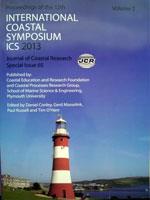Bass, S.J., 2013. Characterising the ambient noise wave breaking environment on a sandy beach.
The interest in wave-generated noise is driven by the relationship with energy dissipation. Studies of deep-water waves show that the sound intensity due to wave-breaking correlates with the energy dissipation rate and it has been demonstrated that passive acoustic methods are a viable means of monitoring local wave breaking. Ambient noise measurements in the surf zone of a sandy beach are analysed for one four-hour measurement period over high water and the results are used to identify individual locally breaking waves from which dissipation rates are estimated. Estimates of wave energy dissipation agree broadly with those estimated using a weighted Rayleigh distribution to predict the breaking wave probability distribution. However, predicted dissipation rates displayed greater variability and an overall lower net dissipation over the measurement period when compared with dissipation estimated using the measured breaking wave fraction.





